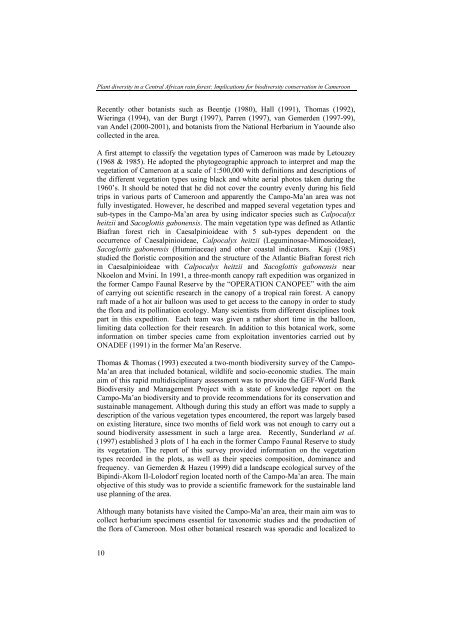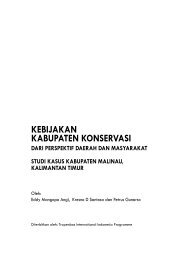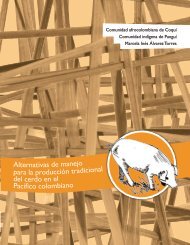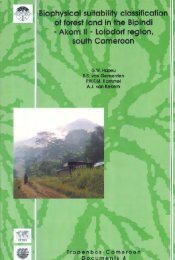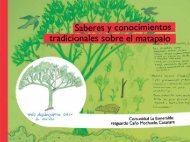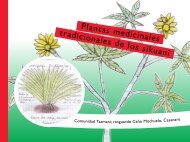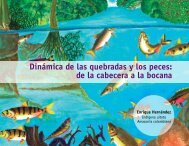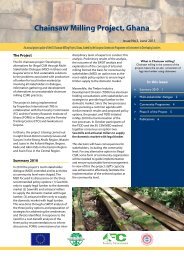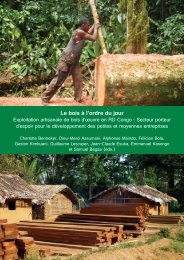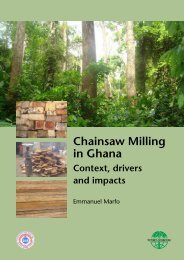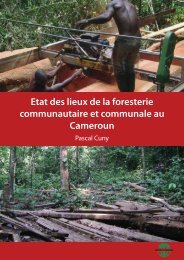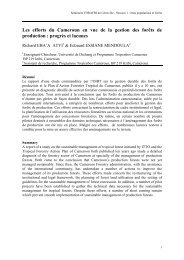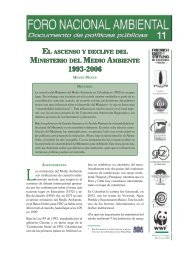Download the publication - Tropenbos International
Download the publication - Tropenbos International
Download the publication - Tropenbos International
You also want an ePaper? Increase the reach of your titles
YUMPU automatically turns print PDFs into web optimized ePapers that Google loves.
Plant diversity in a Central African rain forest: Implications for biodiversity conservation in Cameroon<br />
Recently o<strong>the</strong>r botanists such as Beentje (1980), Hall (1991), Thomas (1992),<br />
Wieringa (1994), van der Burgt (1997), Parren (1997), van Gemerden (1997-99),<br />
van Andel (2000-2001), and botanists from <strong>the</strong> National Herbarium in Yaounde also<br />
collected in <strong>the</strong> area.<br />
A first attempt to classify <strong>the</strong> vegetation types of Cameroon was made by Letouzey<br />
(1968 & 1985). He adopted <strong>the</strong> phytogeographic approach to interpret and map <strong>the</strong><br />
vegetation of Cameroon at a scale of 1:500,000 with definitions and descriptions of<br />
<strong>the</strong> different vegetation types using black and white aerial photos taken during <strong>the</strong><br />
1960’s. It should be noted that he did not cover <strong>the</strong> country evenly during his field<br />
trips in various parts of Cameroon and apparently <strong>the</strong> Campo-Ma’an area was not<br />
fully investigated. However, he described and mapped several vegetation types and<br />
sub-types in <strong>the</strong> Campo-Ma’an area by using indicator species such as Calpocalyx<br />
heitzii and Sacoglottis gabonensis. The main vegetation type was defined as Atlantic<br />
Biafran forest rich in Caesalpinioideae with 5 sub-types dependent on <strong>the</strong><br />
occurrence of Caesalpinioideae, Calpocalyx heitzii (Leguminosae-Mimosoideae),<br />
Sacoglottis gabonensis (Humiriaceae) and o<strong>the</strong>r coastal indicators. Kaji (1985)<br />
studied <strong>the</strong> floristic composition and <strong>the</strong> structure of <strong>the</strong> Atlantic Biafran forest rich<br />
in Caesalpinioideae with Calpocalyx heitzii and Sacoglottis gabonensis near<br />
Nkoelon and Mvini. In 1991, a three-month canopy raft expedition was organized in<br />
<strong>the</strong> former Campo Faunal Reserve by <strong>the</strong> “OPERATION CANOPEE” with <strong>the</strong> aim<br />
of carrying out scientific research in <strong>the</strong> canopy of a tropical rain forest. A canopy<br />
raft made of a hot air balloon was used to get access to <strong>the</strong> canopy in order to study<br />
<strong>the</strong> flora and its pollination ecology. Many scientists from different disciplines took<br />
part in this expedition. Each team was given a ra<strong>the</strong>r short time in <strong>the</strong> balloon,<br />
limiting data collection for <strong>the</strong>ir research. In addition to this botanical work, some<br />
information on timber species came from exploitation inventories carried out by<br />
ONADEF (1991) in <strong>the</strong> former Ma’an Reserve.<br />
Thomas & Thomas (1993) executed a two-month biodiversity survey of <strong>the</strong> Campo-<br />
Ma’an area that included botanical, wildlife and socio-economic studies. The main<br />
aim of this rapid multidisciplinary assessment was to provide <strong>the</strong> GEF-World Bank<br />
Biodiversity and Management Project with a state of knowledge report on <strong>the</strong><br />
Campo-Ma’an biodiversity and to provide recommendations for its conservation and<br />
sustainable management. Although during this study an effort was made to supply a<br />
description of <strong>the</strong> various vegetation types encountered, <strong>the</strong> report was largely based<br />
on existing literature, since two months of field work was not enough to carry out a<br />
sound biodiversity assessment in such a large area. Recently, Sunderland et al.<br />
(1997) established 3 plots of 1 ha each in <strong>the</strong> former Campo Faunal Reserve to study<br />
its vegetation. The report of this survey provided information on <strong>the</strong> vegetation<br />
types recorded in <strong>the</strong> plots, as well as <strong>the</strong>ir species composition, dominance and<br />
frequency. van Gemerden & Hazeu (1999) did a landscape ecological survey of <strong>the</strong><br />
Bipindi-Akom II-Lolodorf region located north of <strong>the</strong> Campo-Ma’an area. The main<br />
objective of this study was to provide a scientific framework for <strong>the</strong> sustainable land<br />
use planning of <strong>the</strong> area.<br />
Although many botanists have visited <strong>the</strong> Campo-Ma’an area, <strong>the</strong>ir main aim was to<br />
collect herbarium specimens essential for taxonomic studies and <strong>the</strong> production of<br />
<strong>the</strong> flora of Cameroon. Most o<strong>the</strong>r botanical research was sporadic and localized to<br />
10


